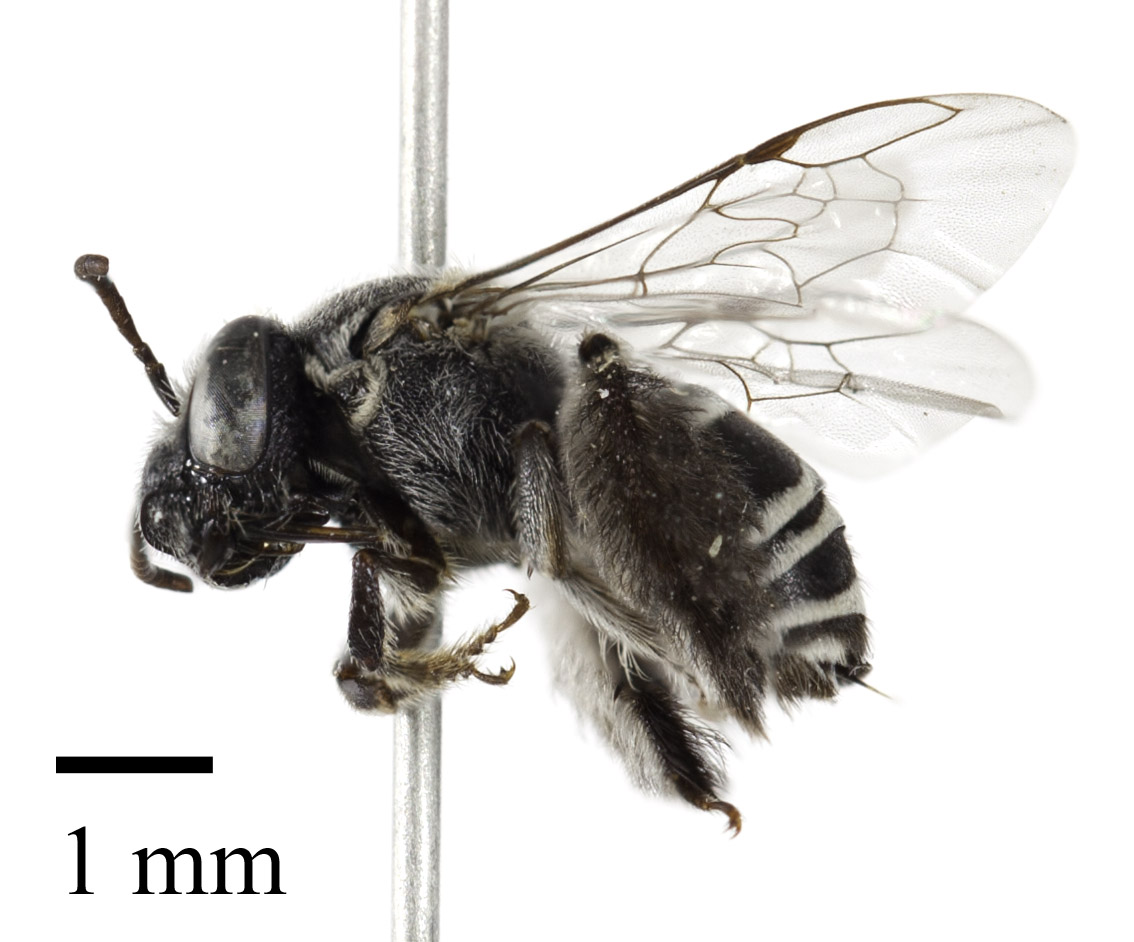Abstract
The genus Ancyloscelis Latreille, 1829 (Hymenoptera: Apidae), a taxon restricted to the Neotropics and southern Nearctic (Michener 1942, 2000, 2007; Schaller and Roig-Alsina 2021; Melo 2022), has been difficult to place precisely within the higher classification of bees (Roig-Alsina and Michener 1993; Aguiar et al. 2019; Freitas et al. 2020), and even the genus name has a confusing history (see Michener 1942). Michener (1944) placed it together with Exomalopsis Spinola, 1853 within the Exomalopsini Vachal, 1909, and Michener and Moure (1957) later expanded this tribe to include ten additional genera, with Ancyloscelis the sole member of one of the five distinct sections they recognized (reviewed by Silveira 1993). Later, Jesus S. Moure (cited in Roig-Alsina and Michener 1993) suggested that the placement of Ancyloscelis should be within Emphorini Robertson, 1904, a position supported in that work. However, Roig-Alsina and Michener (1993) concluded that it differed enough from other members to recognize two subtribes, proposing Ancyloscelina Roig-Alsina and Michener, 1993 containing only the type genus, with the remaining Emphorini recognized at that time (i.e., Diadasia Patton, 1879, Diadasina Moure, 1950, Melitoma Lepeletier and Serville, 1828, and Ptilothrix Smith, 1853) placed in subtribe Emphorina Robertson, 1904. Michener (2000, 2007) and others (Silveira et al. 2002, Rodríguez and Roig-Alsina 2004) continued to recognize Ancyloscelis within Emphorini, but subtribal classifications were not used in those works.
References
- Aguiar, A.J.C., Melo, G.A.R., Vasconcelos, T.N.C., Gonçalves, R.B., Giugliano, L. & Martins, A.C. (2019) Biogeography and early diversification of Tapinotaspidini oil-bees support presence of Paleocene savannas in South America. Molecular Phylogenetics and Evolution, 143, 106692. https://doi.org/10.1016/j.ympev.2019.106692
- Ascher, J.S. & Pickering, J. (2022) Discover Life bee species guide and world checklist (Hymenoptera: Apoidea: Anthophila). Available from: https://www.discoverlife.org/mp/20q?guide=Apoidea_species&flags=HAS (accessed 19 December 2022)
- Cardinal, S., Straka, J. & Danforth, B.N. (2010) Comprehensive phylogeny of apid bees reveals the evolutionary origins and antiquity of cleptoparasitism. Proceedings of the National Academy of Sciences, 107 (37), 16207–16211. https://doi.org/10.1073/pnas.1006299107
- Engel, M.S. (2005) Family-group names for bees (Hymenoptera: Apoidea). American Museum Novitates, 3476, 1–33. https://doi.org/10.1206/0003-0082(2005)476[0001:FNFBHA]2.0.CO;2
- Engel, M.S., Rasmussen, C. & Gonzalez, V.H. (2020) Bees. In: Starr, C. (Ed.), Encyclopedia of Social Insects. Springer, Cham, pp. 1–17. https://doi.org/10.1007/978-3-319-90306-4_14-1
- Freitas, F.V., Branstetter, M.G., Griswold, T. & Almeida, E.A.B. (2020) Partitioned gene-tree analyses and gene-based topology testing help resolve incongruence in a phylogenomic study of host-specialist bees (Apidae: Eucerinae). Molecular Biology and Evolution, 38 (3), 1090–1100. https://doi.org/10.1093/molbev/msaa277
- Freitas, F.V., Branstetter, M.G., Casali, D.M., Aguiar, A.J.C., Griswold, T. & Almeida, E.A.B. (2022) Phylogenomic dating and Bayesian biogeography illuminate an antitropical pattern for eucerine bees. Journal of Biogeography, 49 (6), 1034–1047. https://doi.org/10.1111/jbi.14359
- Hedtke, S.M., Patiny, S. & Danforth, B.N. (2013) The bee tree of life: A supermatrix approach to apoid phylogeny and biogeography. BMC Evolutionary Biology, 13, 138. https://doi.org/10.1186/1471-2148-13-138
- Integrated Taxonomic Information System (ITIS) (2022) Integrated Taxonomic Information System (ITIS) on-line database. Available from: www.itis.gov (19 December 2022)
- International Commission on Zoological Nomenclature (ICZN) (1985) International Code of Zoological Nomenclature. Third Edition. International Trust for Zoological Nomenclature, England, xx + 338 pp.
- Melo, G.A.R. (2022) Ancyloscelidini Roig-Alsina & Michener, 1993. In: Moure, J.S., Urban, D. & Melo, G.A.R. (Orgs). Catalogue of Bees (Hymenoptera, Apoidea) in the Neotropical Region - online version. Available from: http://www.moure.cria.org.br/catalogue (accessed 12 Dec 2022)
- Michener, C.D. (1942) North American bees of the genus Ancyloscelis (Hymenoptera, Anthophoridae). The Pan-Pacific Entomologist, 18 (3), 108–113.
- Michener, C.D. (1944) Comparative external morphology, phylogeny, and a classification of the bees. Bulletin of the American Museum of Natural History, 82, 151–326.
- Michener, C.D. (2000) The Bees of the World. The Johns Hopkins University Press, Baltimore, Maryland, xiv + 889 pp.
- Michener, C.D. (2007). The Bees of the World. Second Edition. The Johns Hopkins University Press, Baltimore, Maryland, xvi + 953 pp. https://doi.org/10.56021/9780801885730
- Michener, C.D. & Moure, J.S. (1957) A study of the classification of the more primitive non-parasitic anthophorine bees. Bulletin of the American Museum of Natural History, 112, 395–452.
- Moure, J.S., Urban, D. & Melo, G.A.R. (2012) Catalogue of Bees (Hymenoptera, Apoidea) in the Neotropical Region—online version. Available from: http://www.moure.cria.org.br/catalogue (accessed 12 Dec 2022)
- Plant, J.D. & Paulus, H.F. (2016) Evolution and phylogeny of bees. Review and cladistic analysis in light of morphological evidence (Hymenoptera, Apoidea). Zoologica, 161, 1–368.
- Porto, D.S. & Almeida, E.A.B. (2021) Corbiculate bees (Hymenoptera: Apidae): Exploring the limits of morphological data to solve a hard phylogenetic problem. Insect Systematics and Diversity, 5 (3), 1–40. https://doi.org/10.1093/isd/ixab008
- Rodríguez, M.F. & Roig-Alsina, A. (2004) Especies de Ancyloscelis Latreille del sur de Sudamékrica (Hymenoptera, Apidae) con aparato bucal no modificado: nuevas especies y notas sinonímicas. Revista del Museo Argentino de Ciencias Naturales, nueva serie, 6 (2), 351–361. https://doi.org/10.22179/REVMACN.6.94
- Roig-Alsina, A. & Michener, C.D. (1993) Studies of the phylogeny and classification of long-tongued bees (Hymenoptera: Apoidea). The University of Kansas Science Bulletin, 55 (4), 123–173. https://doi.org/10.5962/bhl.part.775
- Schaller, A. & Roig-Alsina, A. (2021) A revision of the bee genus Ancyloscelis (Hymenoptera: Apidae) in Argentina. Zootaxa, 4980 (3), 521–540. https://doi.org/10.11646/zootaxa.4980.3.4
- Silveira, F.A. (1993). Phylogenetic relationships of the Exomalopsini and Ancylini. The University of Kansas Science Bulletin, 55, 163–173.
- Silveira, F.A. (1995) Phylogenetic relationships and classification of Exomalopsini with a new tribe Teratognathini (Hymenoptera: Apoidea). The University of Kansas Science Bulletin, 55 (12), 425–454. https://doi.org/10.5962/bhl.part.780
- Silveira, F.A., Melo, G.A.R. & Almeida, E.A.B. (2002) Abelhas Brasileiras, Sistemática e Identificação. Belo Horizonte, Silveira, 253 pp.


